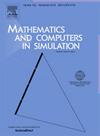基于变分迭代法(VIM)的非零和微分对策反馈纳什均衡解(FBNES)求解方法
IF 4.4
2区 数学
Q1 COMPUTER SCIENCE, INTERDISCIPLINARY APPLICATIONS
引用次数: 0
摘要
在本文中,我们应用了一种称为变分迭代法(VIM)的半解析方法来求解非零和微分博弈(nzsdg)。该方法将Hamilton-Jacobi-Bellman (HJB)方程作为偏微分方程(PDE),利用修正函数进行迭代逼近。这种方法使我们能够获得值函数的近似值,反馈纳什均衡解(FBNES),以及最优性能指数(PI)的估计。该方法为求解nzsdg提供了一种简单的方法,并应用于两种情况下的线性二次模型和两种应用的非线性情况下的求解。请注意,为了突出它们的实际相关性,我们选择了这些模型。算例的数值结果表明,所提出的方法能以较高的精度生成近似解。在Banach不动点定理(BFPT)的基础上,研究并讨论了该方法的收敛性。此外,对比分析了该方法与后向四阶龙格-库塔(BRK4)方法和后向有限差分(BFD)方法的效率和准确性。结果表明,VIM在显著减少迭代次数的情况下,获得了相似或更高的精度,同时提高了计算效率。与依赖离散化的BRK4和BFD方法不同,VIM生成连续分析解,为解决微分博弈问题提供了更大的灵活性和更高的准确性。本文章由计算机程序翻译,如有差异,请以英文原文为准。
A computational method for finding feedback Nash equilibrium solutions (FBNES) in Nonzero-Sum Differential Games (NZSDG) Based on the Variational Iteration Method (VIM)
In this paper, we applied a semi-analytical approach called the Variational Iteration Method (VIM) to solve Nonzero-Sum Differential Games (NZSDGs). With this method, the Hamilton–Jacobi–Bellman (HJB) equation as a partial differential equation (PDE) is approximated iteratively using a correction function. This approach allows us to obtain approximations of the value functions, the feedback Nash equilibrium solutions (FBNES), and an estimation of the optimal performance index (PI). The proposed method provides a simple way to solve NZSDGs and is applied to obtain solutions for both linear-quadratic models in two scenarios and two applied nonlinear cases. Note that, to highlight their practical relevance, we have selected these models. The numerical results of the presented case studies demonstrate that the proposed method can generate approximate solutions with high accuracy. The convergence of the method, based on the Banach fixed point theorem (BFPT), is investigated and discussed in all examples. Additionally, a comparative analysis evaluates the efficiency and accuracy of the proposed method against the backward fourth-order Runge–Kutta (BRK4) method and the backward finite difference (BFD) scheme. Results show that VIM achieves similar or higher accuracy with significantly fewer iterations, while enhancing computational efficiency. Unlike the BRK4 and BFD methods, which rely on discretization, the VIM generates a continuous analytical solution, offering greater flexibility and improved accuracy for solving differential game problems.
求助全文
通过发布文献求助,成功后即可免费获取论文全文。
去求助
来源期刊

Mathematics and Computers in Simulation
数学-计算机:跨学科应用
CiteScore
8.90
自引率
4.30%
发文量
335
审稿时长
54 days
期刊介绍:
The aim of the journal is to provide an international forum for the dissemination of up-to-date information in the fields of the mathematics and computers, in particular (but not exclusively) as they apply to the dynamics of systems, their simulation and scientific computation in general. Published material ranges from short, concise research papers to more general tutorial articles.
Mathematics and Computers in Simulation, published monthly, is the official organ of IMACS, the International Association for Mathematics and Computers in Simulation (Formerly AICA). This Association, founded in 1955 and legally incorporated in 1956 is a member of FIACC (the Five International Associations Coordinating Committee), together with IFIP, IFAV, IFORS and IMEKO.
Topics covered by the journal include mathematical tools in:
•The foundations of systems modelling
•Numerical analysis and the development of algorithms for simulation
They also include considerations about computer hardware for simulation and about special software and compilers.
The journal also publishes articles concerned with specific applications of modelling and simulation in science and engineering, with relevant applied mathematics, the general philosophy of systems simulation, and their impact on disciplinary and interdisciplinary research.
The journal includes a Book Review section -- and a "News on IMACS" section that contains a Calendar of future Conferences/Events and other information about the Association.
 求助内容:
求助内容: 应助结果提醒方式:
应助结果提醒方式:


